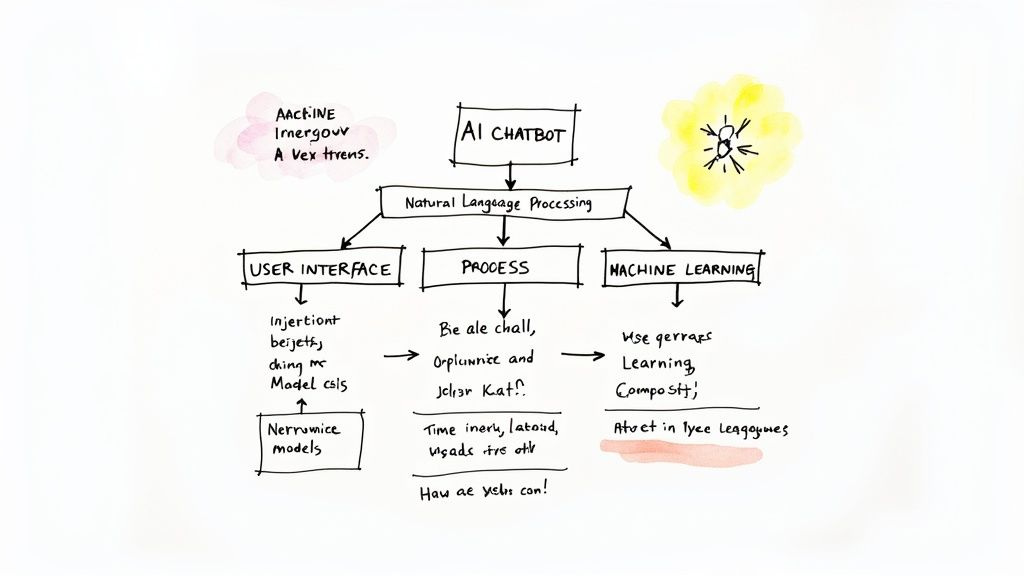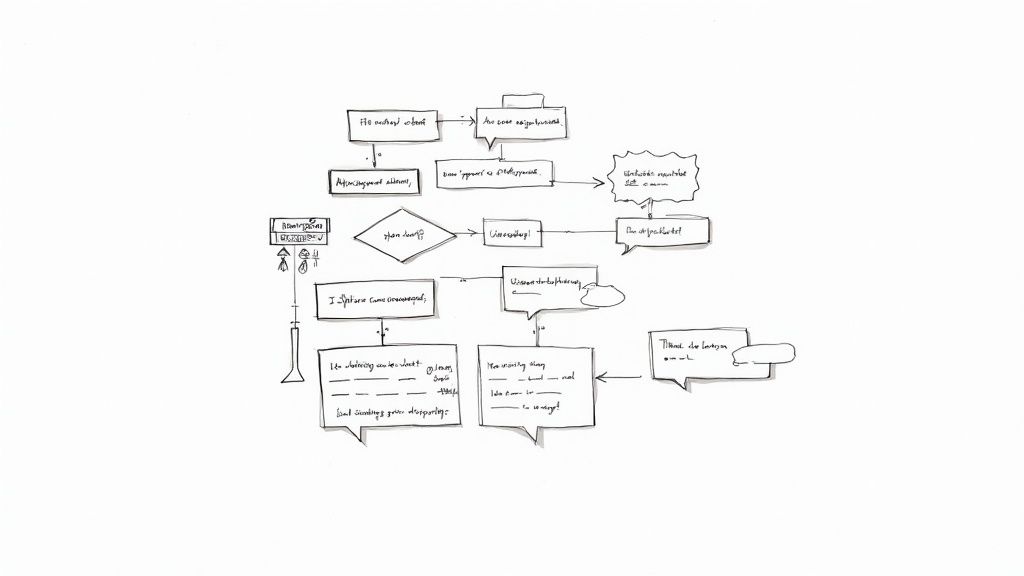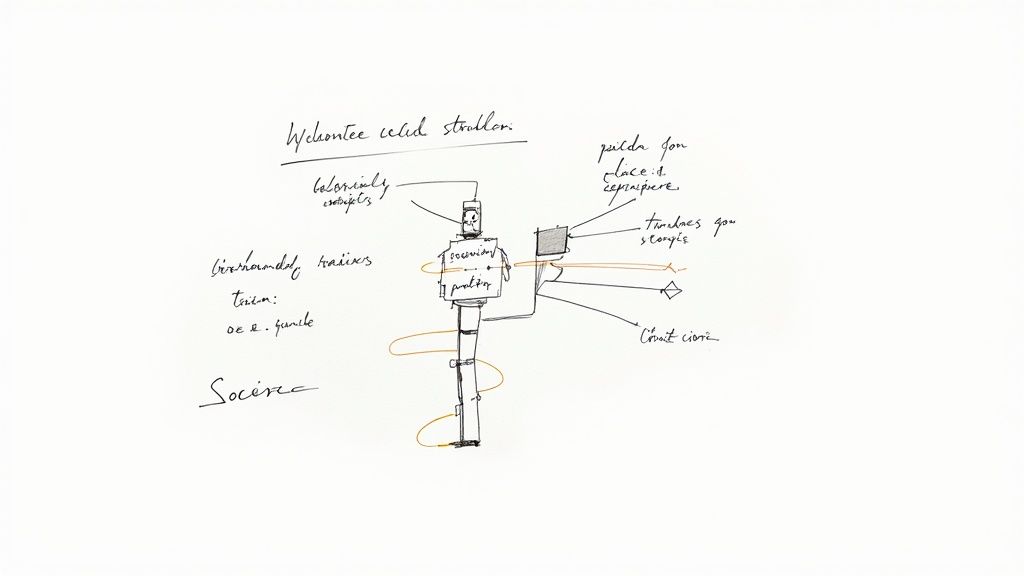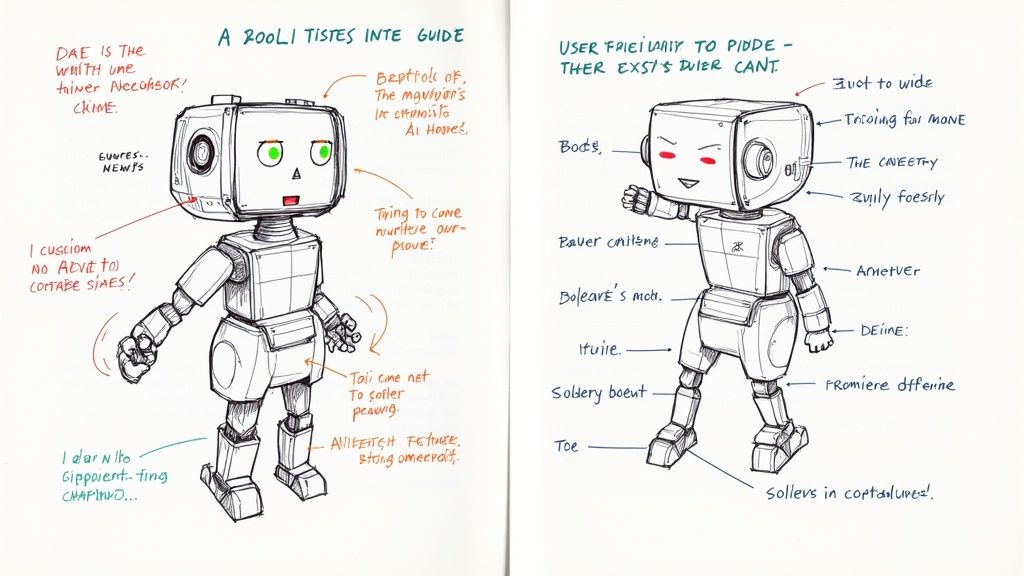AI Chatbot Development: Complete Beginner’s Guide
Starting Your AI Chatbot Journey (Without Getting Lost)

Creating an AI chatbot might seem overwhelming at first, but breaking it down into manageable steps makes the process much clearer. This section will walk you through the key elements you need to understand and consider when building your first chatbot, helping you make smart choices at each stage of development.
Understanding the Fundamentals of AI Chatbots
When learning how to make an AI chatbot, start with the basic building blocks. AI chatbots rely on two main technologies: Natural Language Processing (NLP) and Machine Learning (ML). Think of NLP as your chatbot's ability to understand human language - it breaks down messages to figure out what users are actually asking for. For example, when someone types "What's the weather like today?", NLP helps the chatbot understand they want current weather information for their location.
ML takes this understanding further by helping your chatbot improve over time. It's similar to how we learn from experience - the more conversations your chatbot has, the better it gets at recognizing patterns and providing helpful answers. This combination of NLP and ML allows your chatbot to handle real conversations rather than just responding to exact phrases.
Defining Your Chatbot's Purpose and Scope
Before writing any code or choosing tools, you need a clear vision for your chatbot. Ask yourself: What specific problems will it solve? Which tasks should it handle? Having concrete answers to these questions will guide your entire development process. It's often best to start small - focus on doing one thing really well rather than trying to handle everything at once. You can always expand your chatbot's capabilities later once you've mastered the basics.
Planning for Success: Core Components of an AI Chatbot
With your goals defined, it's time to plan out your chatbot's essential parts. Each component plays a specific role in creating a smooth, effective user experience:
- Conversation Flow Design: Map out how conversations should progress, including common questions, possible responses, and ways to handle unexpected inputs
- Knowledge Base: Build a solid foundation of information your chatbot can reference when answering questions
- User Interface (UI): Create a simple, friendly way for users to interact with your chatbot
- Integration with Existing Systems: Plan how your chatbot will connect with your current website, apps, or customer service tools
Getting these components right creates a strong foundation for your chatbot. With this groundwork in place, you'll be ready to choose the right technical tools to bring your chatbot to life.
Choosing Tools That Actually Work
The foundation of any successful AI chatbot lies in selecting the right development tools after establishing your plan. The key is matching the tools to your specific needs and technical abilities rather than defaulting to the most popular options. Making an informed choice early prevents running into technical roadblocks or budget issues later.
Code-Based vs. No-Code Platforms: Finding Your Fit
When building your chatbot, you'll need to decide between code-based and no-code platforms. Code-based solutions like Dialogflow give you complete control over your chatbot's functionality through programming. While this requires technical expertise and takes longer to master, it's essential for chatbots that need specialized features or complex integrations.
No-code builders offer a more accessible path through visual interfaces where you can design your chatbot without writing code. These platforms work well for straightforward customer service or lead generation chatbots. However, they may not support certain advanced features - like connecting to older software systems through custom APIs - that code-based options handle easily.
Key Features to Consider
Whether you choose code-based or no-code development, certain core features determine how well your chatbot will perform. These capabilities directly affect its ability to understand users, provide helpful responses, and grow with your business:
- Natural Language Processing (NLP) Engine: The quality of your NLP engine determines how accurately your chatbot interprets different ways users phrase their questions and requests
- Machine Learning (ML) Capabilities: Built-in ML helps your chatbot get smarter over time by learning from conversations and adapting to new types of questions
- Integrations: Your chatbot should connect smoothly with your existing tools like your website, CRM, and support systems to create a seamless experience
- Analytics and Reporting: Detailed data about conversation patterns, user satisfaction, and common questions helps you continuously improve your chatbot
- Scalability: Pick a platform that can handle growing message volumes without slowing down - this prevents having to switch platforms later
Evaluating Popular Platforms
Looking at specific examples helps make these features concrete. Rasa and Amazon Lex are robust code-based platforms for building advanced chatbots, though they require significant development skills.
For simpler needs, no-code platforms like ManyChat, Chatfuel, and Landbot let you build functional chatbots through drag-and-drop interfaces. While they offer fewer customization options, they work well for many basic business uses.
Sitebot offers an interesting middle ground - it provides the ease of no-code development while still allowing advanced customization. Small and medium businesses can quickly create AI chatbots matched to their content and brand without extensive technical knowledge.
The right platform depends on your specific situation. Consider your team's technical skills, your budget, and your long-term goals. Remember that building an effective chatbot takes time and iteration. Start by clearly defining what you need, then choose tools that align with those requirements. This focused approach leads to better results than simply following industry trends.

Designing Conversations That Feel Human
Once you've chosen the right tools for your AI chatbot, the real work begins - making it talk like a human. Good conversational design is about more than just accurate answers. It's about creating natural back-and-forth exchanges that actually help users solve their problems. Let's explore how to build chatbot conversations that connect with people.
Mapping Natural Conversation Flows
The best chatbot conversations mirror how humans naturally talk to each other. Start by planning out common conversation paths - like a chat GPS that guides users to their destination. For instance, if someone visits an online store, the chatbot might open with "What brings you here today?" then direct them to products or support based on their answer. Each response should lead logically to the next step, just like a real conversation would flow.
Handling the Unexpected: Gracefully Navigating User Input
Of course, real conversations rarely stick to the script. People ask questions in weird ways, go off on tangents, or suddenly switch topics. That's where good natural language processing (NLP) comes in handy. Your chatbot needs to catch the main point even when users phrase things oddly. It also needs graceful ways to handle confusion, like saying "Could you rephrase that?" or "Let me get a human to help." These fallbacks keep the conversation moving when things go off track.
Maintaining Context Throughout the Interaction
Just like you'd expect from talking to a person, chatbots need to remember what was already discussed. If someone asks about a product's price, the chatbot should recall that product when they later ask about shipping. This context awareness, managed through your chatbot platform's memory features, creates smoother conversations where users don't have to repeat themselves. It makes the whole experience feel more natural and efficient.
Adding Personality and Maintaining Engagement
While functionality comes first, giving your chatbot some personality turns it from a tool into a friendly helper. You don't need an elaborate character - just sprinkle in appropriate humor, show empathy when needed, and match your brand's voice. Simple touches like using the occasional emoji, acknowledging when users seem frustrated, and offering warm greetings can make interactions more enjoyable. Just keep the personality light enough that it supports rather than overshadows the chatbot's main job of helping users. Focus on these conversation design principles, and you'll create a chatbot that people actually enjoy talking to.
Training Your Bot for Real Intelligence

Creating a truly smart AI chatbot goes beyond just setting up basic conversation flows. The key lies in properly training your bot to understand and respond naturally to real user interactions. This section walks through the essential training steps needed to develop an AI assistant that can effectively grasp user intent and provide helpful responses.
Data Curation: The Foundation of a Smart Chatbot
Like humans learning from experience, chatbots need quality data to develop their capabilities. The data you feed your chatbot directly shapes how well it performs. It's essential to gather relevant, accurate information and organize it in a way your bot can process effectively. For instance, if you're building a support chatbot for an online store, you'll want to include details about products, shipping options, and return policies in your training data.
Implementing Continuous Learning
Training a chatbot isn't a one-and-done process - it needs ongoing refinement. As users interact with your bot, those conversations generate valuable real-world data that helps improve its understanding and responses. Regular analysis of chat logs and user feedback points to areas needing adjustment. By periodically retraining your bot with fresh data, you ensure it stays sharp and in tune with user needs.
Balancing Rule-Based Systems and Machine Learning
Effective chatbots often combine two approaches: rule-based systems and machine learning. Rule-based systems work well for handling common, straightforward questions with consistent answers. But they can be rigid. Machine learning adds flexibility by helping bots understand language variations and handle unexpected questions. Finding the right mix of both approaches creates a bot that's both reliable and adaptable.
Improving Response Accuracy and Handling Complex Queries
A chatbot's success comes down to how accurately and helpfully it responds to users. This requires careful training and constant fine-tuning. Some key techniques that boost accuracy include:
- Entity Recognition: Picking out important details like product names or dates from user messages
- Sentiment Analysis: Reading the emotional tone to respond appropriately
- Contextual Awareness: Keeping track of conversation history to maintain relevant discussions
By focusing on these aspects and committing to ongoing improvements, you can build a chatbot that truly understands and assists users effectively. This detailed attention to training is what sets apart basic Q&A bots from genuinely helpful AI assistants.
Building Features Users Actually Want

Once you've got your AI chatbot conversing naturally with users, it's time to add features that create real value. The key is focusing on capabilities that actually improve how people interact with your chatbot, rather than adding flashy extras that look impressive but don't serve a clear purpose. Let's explore the most important features to consider, starting with core functionalities that make your chatbot more useful and ending with advanced capabilities that can take the experience to the next level.
Seamless System Integrations
Getting your chatbot to work smoothly with your existing tools and platforms makes a huge difference in its usefulness. Think of a customer service chatbot that can pull up someone's recent orders or check if an item is in stock without making them wait or switch to another system. When you connect your chatbot to tools like Slack or Zendesk, your team can handle customer conversations more efficiently too. These connections help create a smoother experience for everyone involved.
Multilingual Support: Expanding Your Reach
Speaking your customers' language matters - literally. Adding support for multiple languages helps you connect with more people, but it takes more than just running everything through a translation tool. You need to account for how people actually communicate in different cultures and regions. This kind of thoughtful language support shows users you care about making the chatbot accessible to everyone, which is especially important if you work with customers around the world.
Contextual Awareness: Remembering the Conversation
Good chatbots remember what you've been talking about, just like a person would. For example, if someone asks about a product and then wants to know about shipping, the chatbot should automatically know they're asking about shipping that specific item. This kind of memory makes conversations feel natural and saves users from having to repeat themselves. It's the difference between talking to a smart assistant and just getting pre-written answers from a basic Q&A system.
Advanced Features That Enhance UX
The right advanced features can make your chatbot even more helpful. Sentiment analysis helps it pick up on how users are feeling - if someone seems frustrated, the chatbot can adjust its tone or get a human involved. Entity recognition lets it spot important details like dates and product names in messages, making it better at understanding what users need. And connecting to other services through APIs expands what your chatbot can do.
But as you add these features, keep testing to make sure your chatbot stays fast and responsive. Focus on adding capabilities your users actually need, based on how they're really using the chatbot. A simple chatbot that works well will always beat one with lots of fancy features that slow it down or confuse people. The goal is to make something that helps users get what they need quickly and easily.
Launching and Growing Your Chatbot
You've put extensive effort into creating your AI chatbot. Now it's time to successfully launch and grow your creation. Just as a gardener carefully plans and tends to their garden, you'll need to thoughtfully prepare and nurture your chatbot to help it thrive in real-world conditions. This involves methodical testing, performance tracking, and scaling up capabilities as more users engage with your chatbot.
Testing Your Chatbot: Ensuring a Smooth User Experience
Before releasing your chatbot to the public, thorough testing is essential. Just like test-driving a car before purchase, you want to verify everything works properly. A complete testing process includes:
- Alpha Testing: Have your internal team interact with the chatbot to catch initial issues and bugs
- Beta Testing: Share access with a small group of external users to gather real-world feedback
- A/B Testing: Test different versions of conversation flows and responses to see what resonates best with users, using actual interaction data to guide improvements
Optimizing Performance and Scalability
After launch, closely monitor and fine-tune your chatbot's performance by tracking key metrics:
- Response Time: Monitor how quickly your chatbot answers questions, as slow responses frustrate users
- Accuracy Rate: Track how often your chatbot provides correct, helpful information to build user trust
- Conversation Completion Rate: Measure successful conversations completed without human help to assess your chatbot's effectiveness
These numbers show you where to focus improvements. As more people use your chatbot, make sure it maintains speed and reliability even during peak usage. Choose a platform that can grow with your needs to avoid disruptive changes later.
Monitoring and Continuous Improvement
Launching is just the beginning - your chatbot needs ongoing attention to stay effective. Set up thorough monitoring to track performance, spot problems early, and collect user feedback. Like a gardener regularly tending their plants, you'll want to keep refining and enhancing your chatbot based on real usage data and results.
Measuring Chatbot Effectiveness and Handling Challenges
Define clear metrics tied to your business goals to evaluate your chatbot's impact:
- Customer Satisfaction: Gather feedback through surveys and forms
- Lead Generation: Count new leads coming from chatbot interactions
- Cost Savings: Calculate reduced support costs from chatbot automation
While growing your chatbot brings rewards, challenges will arise. Prepare for common issues:
| Challenge | Solution |
|---|---|
| Unexpected user input | Implement robust NLP training and fallback mechanisms. |
| Maintaining accuracy | Continuously update the chatbot's knowledge base and training data. |
| Scaling with demand | Choose a scalable platform and optimize resource allocation. |
By actively addressing these challenges, your chatbot can become an increasingly valuable business asset. Consistent dedication to improvement helps transform your chatbot from a basic tool into a key driver of engagement and growth.
Ready to launch your own AI chatbot? Sitebot provides an easy-to-use platform for creating and deploying custom chatbots designed for your specific needs. Start building your intelligent virtual assistant today with Sitebot!


